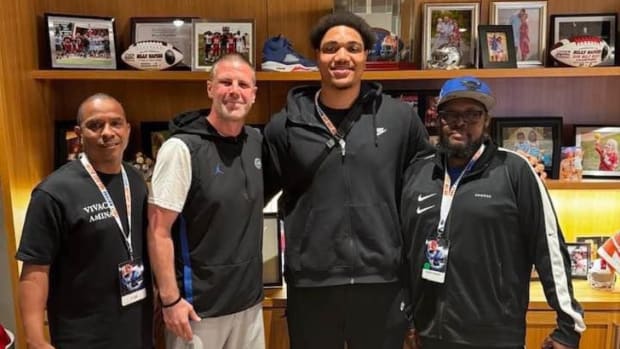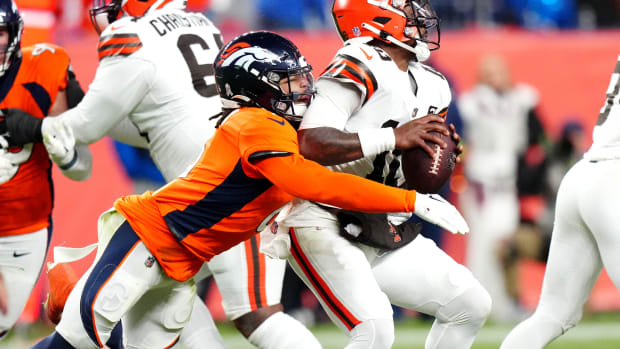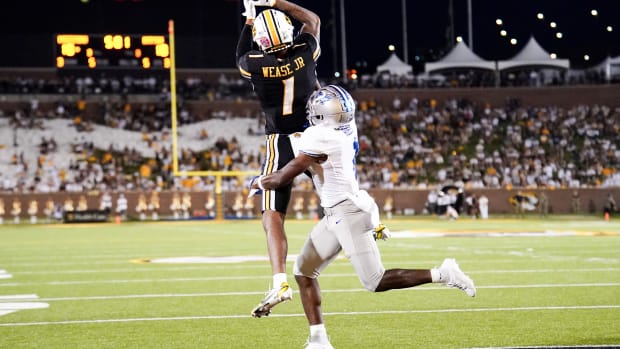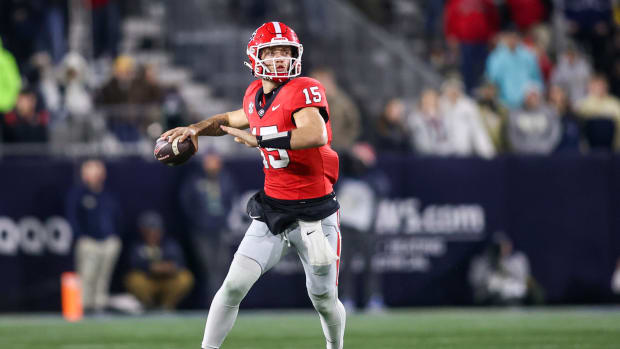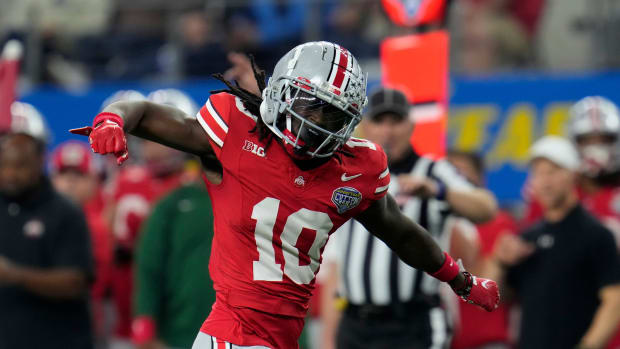Coronavirus Pandemic Magnifies an All-Too-Real Issue for Some NCAA Athletes
Before the world turned upside down, University of Mississippi senior linebacker Sam Williams would eat five-to-six meals per day at campus dining halls—each one necessary to fuel his 6’3”, 250-pound body. His scholarship came with a meal plan, ensuring that he could get the calories necessary to train and perform at the level expected of him. But like many of the 460,000 NCAA athletes who were suddenly sent home last month, he now has to scramble to afford the food he needs.
In late March, he tweeted out his frustrations from his family’s home in Montgomery, Ala.
“We worked so hard to get out the hood but forced back to the hood,” Williams wrote. “Still gotta pay rent so all our money be gone and I can’t swipe my ID nowhere in Alabama. Then if we get help it’s a ‘violation’. I just don’t understand.”
Speaking over the phone last weekend, he explained, “I still need to pay my rent back there [in Oxford] and so after that and my car insurance, it’s whatever is left to pay for groceries.”
The challenges Williams is facing are almost certainly widespread: According to a new report out Tuesday from the Hope Center for College, Community, and Justice at Temple University, 24% of the 452 Division I athletes it surveyed in the fall of 2019 suffered food insecurity in the previous 30 days. The numbers were 26% and 21% for the Divisions II and III student-athletes respectively, and 39% for athletes at two-year schools (3,506 student-athletes were surveyed in total). Among the general college population, the center found that 39% suffer food insecurity, defined in the report as the “limited or uncertain availability of nutritionally adequate and safe food, or the ability to acquire such food in a socially acceptable manner.”
Those numbers, of course, predate the pandemic, which has crashed the economy and made it more difficult for millions of Americans to afford food. That includes athletes—both ones on scholarship, who are no longer able to rely on campus dining halls and training tables, and those without scholarships who were already struggling.
The coronavirus crisis is likely to exacerbate another major problem included in the Hope Center survey: Nearly 14% of D-I student-athletes reported experiencing homelessness in the previous 12 months. The number was 19% for D-II, 13% for D-III and 20% for two-year schools.
Mississippi athletic director Keith Carter tells SI that when he learned of Williams's situation from Twitter, the school adapted on the fly. Any athlete who asks can now receive a weekly meal card valued at $105—an amount that had to be approved by the compliance office—that can be used at “fast-casual” restaurants, like Subway. A grocery store option could be added in the future.
“We couldn't load those meal cards up with unlimited dollars, if you will, and so we had to find a number that we felt comfortable with and that we could use,” Carter says. “It's just not the same when we have them on campus, where there's just so many ways that they have access to so many resources.”
But not all schools have made that type of change and, for most athletes, even receiving help is complicated: Williams intends to play for Mississippi this fall and, to maintain his amateur status with the NCAA, must be careful not to accept money or help that could be construed as resulting from his status as an athlete (the NCAA did not respond to request for comment). Since coming home, he’s continued training and conditioning in his backyard as best as he can.
“The outcome [of a violation] is bigger than the pandemic,” Williams says. He spoke out for a simple reason, he says: athletes like him need to eat.
“I just think that we should get something, especially for food, because we don’t have that resource on campus anymore,” he says.
****
Six years ago, just hours before playing in the national championship, star UConn guard Shabazz Napier told reporters, “We do have hungry nights that we don’t have enough money to get food in.”
Napier wasn’t out to make a statement. He was responding to a question about Northwestern players pushing to unionize. (The National Labor Relations Board eventually denied their request.) Nevertheless, the interview went viral and caught the attention of lawmakers, who then put pressure on the NCAA. Almost immediately, the association lifted restrictions on how much food could be provided to athletes.
Stories of universities with million dollar food budgets appeared to show how the NCAA had stepped up and solved the problem, but the Hope Center survey complicates that picture. While scholarship athletes at D-I schools may have access to meal plans, thousands of other athletes nationwide do not. According to the report, across the three divisions, only about 60% of student-athletes receive scholarships, many of which are partial.
Sara Goldrick-Rab a professor of higher education policy and sociology at Temple University and the founder of the Hope Center, has done annual surveys on food insecurity on college campuses since 2015, but had not previously broken out results for athletes.
“There's a part of me that really thought, though, that athletes get so much extra attention that they really would be substantially less likely to deal with these problems, and I was really wrong,” said Goldrick-Rab.
The survey did not break out which sports the students play or whether they are on scholarship. An additional in-depth survey that will include a larger sample size is planned for the fall, but Goldrick-Rab says there’s already a clear message in her data.
“Even if these results don't extrapolate, meaning that they just don't apply to anybody else, we have 452 just Division I athletes in here, and 24% of them have been food insecure. That’s concerning,” she says. “In the midst of this pandemic, I know that everybody's worried about whether there's going to be a football season this fall, but there's a real chance that these athletes become completely disconnected [from their campus support systems].”
****
What does life look like for a student-athlete with no scholarship or meal plan?
Travon Williams is a senior wide receiver at Temple University. After spending three seasons as a preferred walk-on for the Owls, in November 2018 he finally was awarded a full scholarship for his upcoming senior year. His coach surprised him with the news after a game and the video made its way to ESPN. It was a feel-good story—but also an ending to three years of intense struggle for Williams.
“Because football is all during the day, you're going to work at night,” Williams tells SI. “You start work around 10 p.m. and by the time I look at the clock again, it's time to wake up for football.”
Williams says he averaged 3–4 hours of sleep a night between school, work and football. The money helped cover whatever financial aid couldn’t, but that still didn’t leave enough for a meal plan. If he had practice in the morning, he was guaranteed breakfast, but that would be all until dinner-time unless he could find some snacks in between classes, “and then that would be it.” His coaches noticed that he was losing weight, but he would convince them everything was fine.
“They asked. Like, my strength coach was always asking like, ‘Why are you weighing in so light?’ I’d say ‘I didn’t eat enough yesterday coach, my bad. I'll fix it.’”

Temple receiver Travon Williams during a game in 2017 as a redshirt sophomore.
James Guillory-USA TODAY Sports
Williams didn’t want to bring any attention to his situation and risk not being able to play, so he dealt with the consequences, which included intense migraines. “You don't eat and so your head just starts hurting. So you start getting migraines from not eating. I would get those in class.”
Meals would sometimes consist of nutritionally deficient food that was cheap. Food insecurity isn’t only about being hungry—it’s also about the inability to eat the type of food your body needs to sustain itself. Sometimes, as he was trying to go to sleep, it all just became too much for Williams. “Mad screaming into the pillow,” he says, his voice quiet. “Like wanting to cry, especially, with on top of school, I'd be like, ‘Oh no, how am I to do this?’”
Williams did do it, though. After earning his scholarship, he made sure to pay it forward, offering his meal card to other walk-on players. He’s now headed to graduate school to become a physical therapist.
One Group of Five football coach who spoke to SI on condition of anonymity said he knows that some of his players are struggling. “I see what these Power 5 programs are able to offer their guys. We just don’t have the money for it. I do what I can. I wish I could do more.”
Already, according to a data analysis by the US Department of Education, out of the 2,078 institutions that have athletic programs, 65 schools generated 54% of all college sports revenue. Essentially, 3% of all college programs bring in more than half of all the money. Which is to say, million dollar food budgets are not exactly common.
And the current pandemic could further shift the economics of this entire system. Lead1 Association, which represents the athletic directors of the 130 FBS schools, painted a bleak picture in a report on its annual survey of its members. Released on April 2, “The State of Athletics in the Face of the Coronavirus” warns of long-lasting economic repercussions. One-third of the AD’s interviewed believe their programs will have at least a 30% decrease in revenue for the upcoming 2020–21 academic year. The report adds that over half of the non-Power 5 schools have concerns of revenue reductions of NCAA distributions. And FBS schools are the haves in the NCAA system.
The implications will play out in real time. For players who have experiences like those of Trevon Williams, there will be limited options. Even prior to the pandemic, students were not eligible for Supplemental Nutrition Assistance Program (SNAP) unless they meet specific criteria. On April 10, the USDA declined requests from 29 states to waive certain eligibility requirements in SNAP to better support college students during the COVID-19 pandemic.
Student-athletes still need to abide by the rules set by the NCAA, while continuing to train and condition and maintain a GPA to remain eligible. All while being cut off from critical programs at their universities.
Sam Williams, the Mississippi linebacker, says he’s going to try and find a job, maybe at a Walmart. As for concerns over catching COVID-19? “You gotta do what you gotta do,” he says.

